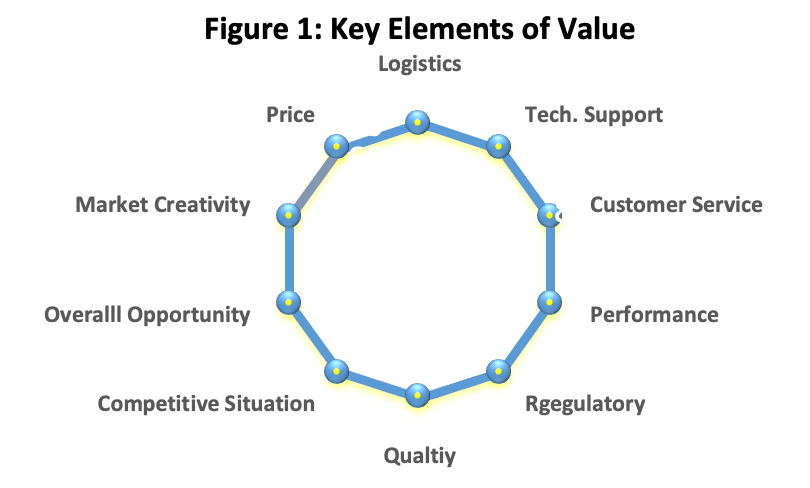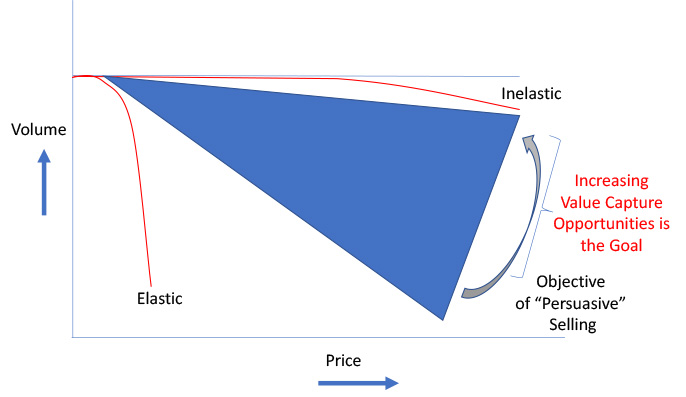Phil Phillips & Gary Shawhan, Contributing Editors
The CHEMARK Consulting Group
The art of “Persuasive Selling” has certainly evolved from the days of the fast-talking, traveling salesman and the three-martini lunch. NO LONGER is product selection and supplier choice a simple matter of personal preference and price.
Each selling situation has its own individual dynamics. In today’s business climate, there are a number of elements that need to be considered in constructing and executing a successful sales strategy. Figure 1 highlights 8 key elements that are important in developing an overall value proposition for a particular product or service.

The art of “Persuasive Selling” is linked to identifying, understanding, and assessing the relative value of each of these elements (Figure 1) to the customer. At the heart of any sales strategy is the ability to show that your company and its products/services can deliver identifiable value to their company and ultimately value they can bring forward to their customers.
To sell a product/service, persuading others to switch from their current supplier to your company, involves the use of tactics that are individual to the company being targeted. There is no one magic formula for success.
Whether selling formulated products, resins, additives, or services, framing the total overall value to the customer is the goal. The sales objective is to identify and bring forward the features/benefits and contrast them effectively with the incumbent supplier’s products/services. This establishes need and creates a basis for change. In its most compelling form, the sales process results in a fear by the customer for the consequences of not instituting such a change.
Price and Value
The art of “Persuasive Selling” is grounded in the ability of the sales team to position the company and their product/service in the most effective way so that price is one of the least important elements for change. The overall value proposition becomes a composite of the various attributes of a given product/service (plus what the company itself brings) in relation to the individual needs of the customer.
Assessment of price elasticity (for the a given product or service) is one way to characterize the relationship between price and value. The extremes of product value are often viewed as either being commodity or as unique, one-of-a-kind. At the one extreme, a perfectly elastic product/market situation is one where any change in price will have an immediate impact on volume. Put one way, little or no differentiation exist between competing products. Price is the primary determinant of which supplier will be successful.
Figure 2 depicts the difference between an elastic and inelastic product or service.

A perfectly elastic product provides little or no opportunity for “Persuasive Selling”.
A perfectly inelastic product/market situation is one in which an increase in price is (almost) independent of volume and customer preference. Products are sufficiently unique and elevated in value that there is no similar or equivalent competing products available from competition.
Value capture opportunities (within reason) abound as the customer has no comparable options available to them.
When considered in the context of value-chain analysis, a product or service that is highly elastic has little or no room forward in the chain to support an increase in price. Value capture opportunities are not available to the customer. There are limited incentives to consider a change in supplier.
The art of “Persuasive Selling” is what occurs between these two extremes. It is the alignment of the value for your company’s products/services with the key issues important to the customer. “Persuasive Selling” positions the merits of your products or services in addressing these issues and shifts the value proposition in the direction of inelasticity (Figure 2).
In today’s CASE markets, among the most important elements impacting the overall value proposition for a product/service, as represented to the customer, are those highlighted in Figure 1.
Benchmarking the competitive situation and identify those elements where your company and product or service brings additional value to the customer is key to this process.
In addition to price and value, the following additional elements are important contributors in maximizing the overall value for your products or services.
Supply Chain, Logistics
In today’s marketplace, supply chain management plays an increasing role in determining suppler choice. Minimizing inventory, satisfying the JIT requirements of the customer, and understanding the expectations forward in the value chain to the ultimate end-user is a key element of value. Supply chain issues need to be incorporated into the selling strategy.
Distribution plays an important role in providing timely availably of product and more flexibility in the quantities that can be purchased. For companies serving highly fragmented markets, often involving a large number of individual products and product variations, a high value is placed on suppliers that can accommodate their needs for timely product supply.
In this regard, having a strong position with key distributors as one of their principle suppliers is a definite asset. Balance in geographic coverage through distribution including regional warehousing capabilities and sales support can set your company apart from your competitors.
Technical Support
Timely and accessible technical support is a key differentiator when considering a change of supplier. As questions or product problems surface, knowing that you are able to talk directly to a real person and not to a recorded voice enhances supplier value.
It is important that the customer feels they can directly access knowledgeable individuals in their supplier’s organization easily. Filling out a form or having to wait for an e-mail or voice mail reply is not what the customer wants to experience when they need an answer to a problem or to a question that comes from one of their customers.
Performance
A center piece for developing an overall value proposition for a product or service is frequently anchored by the performance improvements that can be realized through a change of suppliers. The value of performance improvement is maximized when the customer is experiencing threats to their present business that can be favorably impacted through a supplier change. The fear that accompanies the concern over loss of their customer base can accelerate the drive to make a change in supplier.
In most situations, the value of performance is not a stand-alone reason for making a change. Performance needs to be accompanied by other elements of value to provide a sufficiently persuasive sales argument.
Regulatory
Regulatory compliance, along with issues of environmental friendliness and sustainability, is fundamental to any effort to promote a company’s products/services. Formulators of CASE products and suppliers of additives and resins to these formulators are constantly challenged with the impact that regulatory compliance has on the marketability of their products.
Globally, regulatory activity continues to be a fluid situation. As such, anticipating and positioning your company to remain in compliance within all the geographic areas where you do business is a necessary on-going task. Anything that you can incorporate into the sales strategy that demonstrates that your company is actively looking ahead to ensuring continued compliance is important to potential customers.
Quality
Quality and consistency in quality over-time are always important differentiators. If the incumbent supplier has compromised their credibility through variation in product quality that provides justification for considering a supplier change.
This is especially true when quality issues have become visible to the target company’s customer. The fear that they may lose business to their competitors for quality reason is a compelling argument for change.
Sales Support/Customer Service
A sometimes over-looked value, that separates one supplier from another, is customer service. This includes the support customers receive from the sales force. The bonds that are created between the supplier and the customer as a result of these activities can be far reaching. Vulnerability to change increases when the depth of relationship building between the customer and the supplier is infrequent or non-existent.
Market Creativity
Market knowledge and industry affiliations can bring a unique addition to the value of your company and for the products/services you are proposing as a replacement.
Bringing new business opportunities forward to a target account or providing insight and assistance in entering a new market space is a differentiator. In most situations this value-add effort will also get the attention of top management. In doing so it can strengthen your case throughout much of the decision-making group in the company as a replacement supplier.
Summary
“Persuasive Selling” is grounded in an assessment and understanding of the many elements of the customers business. This represents the Total Sales Value that the sales team can bring to the customer. “Persuasive Selling” is the process of crafting the overall value proposition for your products or services and then delivering compelling reasons for the customer to change suppliers and adopt your product/service.
Using a graphic to illustrate this point, The Umbrella of “Persuasive Selling” (Figure 3) includes all of the 8 elements discussed in this article. But the sales plan needs to go further. Special (customer specific) circumstances also needs to be considered as part of any sales strategy. Frequently there are unique, customer specific issues that can provide added strength to the sales arguments if they are identified and diagnosed by the sales team. Collectively, this is the process of “Persuasive Selling”.

